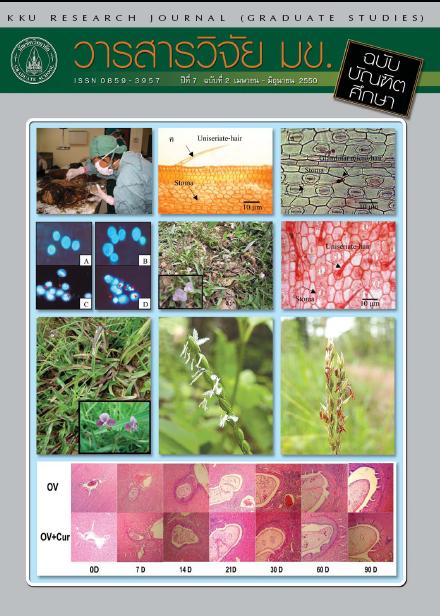A Study of Critical Thinking in Open-ended Mathematical Problem-Solving Situation(การศึกษาการคิดอย่างมีวิจารณญาณในสถานการณ์การแก้ปัญหาแบบปลายเปิดทางคณิตศาสตร์)
Keywords:
Process of critical thinking(กระบวนการคิดอย่างมีวิจารณญาณ), Critical thinking(การคิดอย่างมีวิจารณญาณ), Open-ended situation(สถานการณ์การแก้ปัญหาแบบปลายเปิดทางคณิตศาสตร์)Abstract
การวิจัยครั้งนี้มีวัตถุประสงค์เพื่อวิเคราะห์กระบวนการคิดอย่างมีวิจารณญาณในสถานการณ์การแก้ปัญหาแบบปลายเปิดทางคณิตศาสตร์ ด้วยระเบียบวิธีวิจัยเชิงคุณภาพ เน้นการวิเคราะห์โปรโตคอล (Protocol Analysis) และการบรรยายเชิงวิเคราะห์ (Analytic Description) ตามกรอบแนวคิดเชิงทฤษฎีของ Paul & Elder (2004)
ขั้นตอนการดำเนินการวิจัยคือ 1) คัดเลือกกลุ่มเป้าหมายที่มีความคุ้นเคยกับสถานการณ์ปัญหาแบบปลายเปิด เป็นนักศึกษาสาขาวิชาคณิตศาสตรศึกษาชั้นปีที่ 2 ภาคการศึกษาปลาย ปีการศึกษา 2548 คณะศึกษาศาสตร์ มหาวิทยาลัยขอนแก่น จำนวนทั้งหมด 41 คน กลุ่มเป้าหมายเป็นผู้ที่ผ่านการเรียนในรายวิชา 231 111 กระบวนการแก้ปัญหาคณิตศาสตร์ระดับโรงเรียน ในภาคการศึกษาต้น ปี 2547 และรายวิชา 231 112 กระบวนการพิสูจน์และให้เหตุผลในคณิตศาสตร์ระดับโรงเรียน ในภาคการศึกษาปลาย ปีการศึกษา 2547 และในช่วงการทำวิจัยกลุ่มเป้าหมายกำลังเรียนในรายวิชา 231 214 ภาษาและกระบวนการสื่อสารในคณิตศาสตร์ระดับโรงเรียน ซึ่งมีครูผู้สอนที่มีประสบการณ์และความชำนาญในการจัดการเรียนการสอนโดยใช้วิธีการแบบเปิดมามากกว่า 10 ปี เป็นผู้จัดการเรียนการสอน ในรายวิชาทั้งหมดที่กล่าวมามีการจัดการเรียนการสอนโดยใช้สถานการณ์ปัญหาแบบปลายเปิดตลอดทั้งภาคเรียน รูปแบบของการจัดกิจกรรมการเรียนการสอนในชั้นเรียนมีการแบ่งนักศึกษาเป็นกลุ่มเพื่อทำกิจกรรม และแบ่งช่วงการดำเนินการจัดการเรียนการสอนในชั้นเรียนเป็น 2 ช่วง คือ ช่วงที่หนึ่ง ช่วงที่ผู้เรียนทำกิจกรรมการแก้สถานการณ์ปัญหาแบบปลายเปิด และช่วงที่สอง เป็นการนำเสนอผลงานของกลุ่มหน้าชั้นเรียน โดยทั้งสองช่วงนี้บทบาทของครูผู้สอนเน้นไปที่การตั้งคำถามในเชิง “อะไร” ”อย่างไร” และ“ทำไม” ในช่วงของการทำกิจกรรมการเรียนการสอน เพื่อให้สมาชิกในกลุ่มได้อภิปรายกันภายในกลุ่มและระหว่างกลุ่ม ในช่วงของการนำเสนอนั้นนักศึกษากลุ่มอื่นมีโอกาสที่จะตั้งคำถาม ข้อสงสัย ข้อสังเกตกับกลุ่มที่นำเสนอได้ตลอดเวลา 2) เก็บข้อมูลโดยใช้การบันทึกภาคสนาม การบันทึกเทปเสียงและการบันทึกวีดิทัศน์กลุ่มเป้าหมายซึ่งมีทั้งหมด 3 กลุ่มจากจำนวนกลุ่มทั้งหมด 7 กลุ่ม ในขณะที่แต่ละกลุ่มอยู่ในสถานการณ์ปัญหาแบบปลายเปิดทั้งหมด 3 สถานการณ์ ปัญหา 3) ทำการวิเคราะห์ข้อมูลโดยนำโปรโตคอลที่ได้จากการถอดเทปบันทึกเสียงและวีดิทัศน์ ผลงานที่เป็นงานเขียนในการทำกิจกรรมของนักเรียน บันทึกภาคสนามของผู้วิจัยและผู้ช่วยวิจัยมาทำการวิเคราะห์ข้อมูลโดยใช้การวิเคราะห์โปรโตคอลและการบรรยายเชิงวิเคราะห์ตามกรอบแนวคิดของ Paul & Elder (2004) ผลการวิจัยพบว่า 1)ปฏิสัมพันธ์ระหว่างครูและนักเรียนโดยใช้คำถามในเชิง “อะไร” “อย่างไร” และ”ทำไม” เป็นตัวส่งเสริมการวิเคราะห์การคิดของผู้เรียนโดยตัวผู้เรียนเอง ซึ่งแสดงออกมาในรูปของการให้เหตุผลประเภทต่างๆ 2)ปฏิสัมพันธ์ระหว่างครูและนักเรียนโดยใช้คำถามในเชิง “อะไร” “อย่างไร” และ”ทำไม” เป็นสิ่งที่ช่วยเพิ่มศักยภาพการประเมินการคิดของผู้เรียนเมื่อเทียบกับเกณฑ์มาตรฐานทางสติปัญญาแบบสากล (Universal Intellectual Standard) ซึ่งแสดงออกมาในรูปของการให้เหตุผลในระหว่างอยู่ในสถานการณ์การแก้ปัญหาแบบปลายเปิด ทั้งการวิเคราะห์การคิดของตนเองโดยอาศัยการให้เหตุผลประเภทต่างๆและศักยภาพในการประเมินการคิดของตนเองถือเป็นองค์ประกอบที่สำคัญอย่างยิ่งของการคิดอย่างมีวิจารณญาณ
The objective of the present research was to study the students. critical thinking in an open-ended mathematical problem-solving situation. The study applied qualitative research procedure and was done by means of protocol analysis and analytic description according to Paul & Elder.s theoretical framework (2004). The target group was consisted of 41 second-year students in Mathematics Education Program of the Faculty of Education, Khon Kaen University who enrolled in the 231 214 - Language and Communication Process in School Mathematics Course during the second semester of the 2005 academic year. The students had been enrolled in the 231 111- The Process of Solving School Mathematics Course during the first semester of the 2005 academic year, and 231 112 - The Process of Proving and Reasoning in School Mathematics Course in the second semester of the same academic year. During the course of the present study, an instructor who had considerable experience in teaching school mathematics by means of open-ended method for more than 10 years was responsible for the teaching. Throughout the duration of the study the pattern of open-ended problem-solving situation was used as the main mode of instruction. The students were organized into 7 groups to participate in the activities. The activities were separated into two phases. In the first phase, the students were planned to do the open-ended problem solving activities, and the second phase was for the presentation of group works to the class. The role of the instructor in both phases was to pose questions such as .What?., .How?., and .Why?. in order to encourage group or inter-group discussion. At any point of group presentation, students from other groups were free to pose questions, to express their doubts about the content of the presentation, or to make remarks. Data collection was done by means of video- and tape-recording of the activities. The data gathered from the videoand tape-recording, the students. written works, the present researcher and her co-researcher.s field notes were analyzed by focusing on protocol analysis and analytic description according to Paul & Elder.s theoretical framework (2004). The findings: 1) Interaction between the instructor and the students in the form of the former posing the .what., .how., and .why. types of questions stimulated the students to think critically by yourself. This critical thinking behavior can be observed from the way they explained their reasons. 2) The same interaction between the instructor and the students helped increase assessment potential of the students when compared with universal intellectual standard. More importantly, the analysis of thinking by yourself and the potential of assessment of thinking are crucial aspects of critical thinking process.


